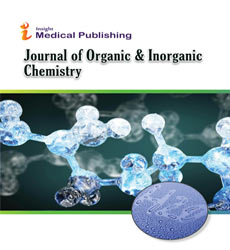Photocatalytic Properties of Transition Metal Complexes: Bridging Organic and Inorganic Systems
Emily Carter
Division of Chemistry and Chemical Engineering, California Institute of Technology, Pasadena, CA, USA
Published Date: 2025-02-28DOI10.36648/2472-1123.11.1.125
Received date: February 03, 2025, Manuscript No. ipjoic-25-20813; Editor assigned date: February 05, 2025, PreQC No. ipjoic-25-20813 (PQ); Reviewed date: February 17, 2025, QC No. ipjoic-25-20813; Revised date: February 22, 2025, Manuscript No. ipjoic-25-20813 (R); Published date: February 28, 2025, DOI: 10.36648/2472-1123.11.1.125
Citation: Carter E (2025) Photocatalytic Properties of Transition Metal Complexes: Bridging Organic and Inorganic Systems. J Org Inorg Chem Vol.11 No.1: 125.
Introduction
Photocatalysis, the acceleration of chemical reactions through light-induced activation, has become a cornerstone of modern chemistry and energy research. Transition metal complexes, with their versatile coordination environments and tunable electronic structures, play a central role in this field. By absorbing light and facilitating redox transformations, these complexes serve as a bridge between organic and inorganic systems, enabling sustainable energy conversion, environmental remediation, and synthetic applications. The photocatalytic potential of transition metal complexes lies in their ability to absorb visible light, undergo charge transfer, and mediate multi-electron redox processes. Their d-orbitals allow for flexible electronic configurations, while ligand design enables fine-tuning of absorption spectra and excited-state lifetimes. Complexes of ruthenium, iridium, copper, and iron have been extensively studied for their strong metal-to-ligand charge transfer properties, which are crucial in driving photochemical processes [1].
Description
The mechanism of photocatalysis in transition metal complexes typically involves light absorption followed by excitation to a singlet or triplet state. This excited state can either transfer energy to substrates or participate in electron transfer processes. Depending on the redox properties of the complex, photocatalysis can proceed via oxidative quenching, reductive quenching, or energy transfer pathways. Such versatility makes transition metal complexes adaptable for diverse photocatalytic applications. Ligand design is critical for optimizing photocatalytic performance. Polypyridyl ligands, phosphines, and N-heterocyclic Carbenes (NHCs) are commonly employed to stabilize metal centers while extending absorption into the visible region. Electron-donating or withdrawing substituents further modulate redox potentials and reactivity. Importantly, ligands derived from bio-inspired or renewable sources contribute to the sustainability of these complexes, aligning photocatalysis with green chemistry principles [2].
One of the most impactful applications of transition metal photocatalysis is solar energy conversion. Complexes such as Ru(bpy)â??ò⺠and its derivatives have been used extensively in Dye-Sensitized Solar Cells (DSSCs), where they harvest sunlight and inject electrons into semiconductor surfaces. Similarly, iridium and copper complexes are being explored for artificial photosynthesis, driving water splitting and carbon dioxide reduction. These systems demonstrate the potential of transition metal complexes in renewable energy technologies [3].
Transition metal complexes also play a transformative role in organic synthesis. Photocatalytic methods enable Câ??C and Câ??N bond formation, oxidative coupling, and radical-mediated transformations under mild conditions. Iridium and ruthenium complexes, in particular, have expanded the toolbox of synthetic chemists by enabling previously inaccessible reaction pathways. The ability to harness visible light as a clean energy source reduces reliance on harsh reagents, making these reactions more sustainable. Beyond energy and synthesis, transition metal photocatalysts are increasingly being applied to environmental remediation. They can degrade organic pollutants, reduce toxic heavy metals, and disinfect water by generating Reactive Oxygen Species (ROS). For example, iron-based complexes mimic natural enzymes such as peroxidases, providing eco-friendly solutions to wastewater treatment. The adaptability of photocatalysts to diverse environmental challenges underscores their broad societal relevance [4].
Natureâ??s photosynthetic machinery has inspired the design of transition metal complexes that mimic biological light-harvesting systems. Manganese, cobalt, and nickel complexes have been explored for water oxidation, emulating the oxygen-evolving complex in photosystem II. Similarly, bioinspired photocatalysts are being developed for hydrogen evolution, bridging the gap between natural and artificial systems. Such efforts highlight the interdisciplinary potential of transition metal complexes at the interface of biology and chemistry. Despite significant progress, several challenges remain in translating transition metal photocatalysts into practical applications [5].
Conclusion
Transition metal complexes represent a vital bridge between organic and inorganic systems in photocatalysis. Their tunable structures, diverse reactivity, and light-harvesting capabilities enable groundbreaking advances in energy, synthesis, and environmental applications. Although challenges of cost and stability persist, ongoing innovations in design and integration are paving the way toward practical, scalable solutions. By harnessing the synergy of organic and inorganic chemistry, transition metal photocatalysts are poised to play a transformative role in shaping a sustainable future.
Acknowledgement
None.
Conflict of Interest
None.
References
- Bünzli JCG. (2006). Benefiting from the unique properties of lanthanide ions. Acc Chem Res39: 53-61.
Google Scholar Cross Ref Indexed at
- Dong H, Sun LD, Yan CH. (2013). Basic understanding of the lanthanide related upconversion emissions. Nanoscale5: 5703-5714.
Google Scholar Cross Ref Indexed at
- Si R, Zhang YW, You LP, Yan CH. (2005). Rare-earth oxide nanopolyhedra, nanoplates and nanodisks. Angew Chem44: 3256-3260.
Google Scholar Cross Ref Indexed at
- Diaz C, Valenzuela ML, Laguna-Bercero MA, Mendoza K, Cartes P. (2021). Solventless preparation of thoria, their inclusion inside SiO2 and TiO2, their luminiscent properties and their photocataltytic behavior. ACS Omega6: 9391-9400.
Google Scholar Cross Ref Indexed at
- Chen X, Mao SS. (2007). Titanium dioxide nanomaterials: Synthesis, properties, modifications and applications. Chemical Reviews107: 2891-2959.
Open Access Journals
- Aquaculture & Veterinary Science
- Chemistry & Chemical Sciences
- Clinical Sciences
- Engineering
- General Science
- Genetics & Molecular Biology
- Health Care & Nursing
- Immunology & Microbiology
- Materials Science
- Mathematics & Physics
- Medical Sciences
- Neurology & Psychiatry
- Oncology & Cancer Science
- Pharmaceutical Sciences
